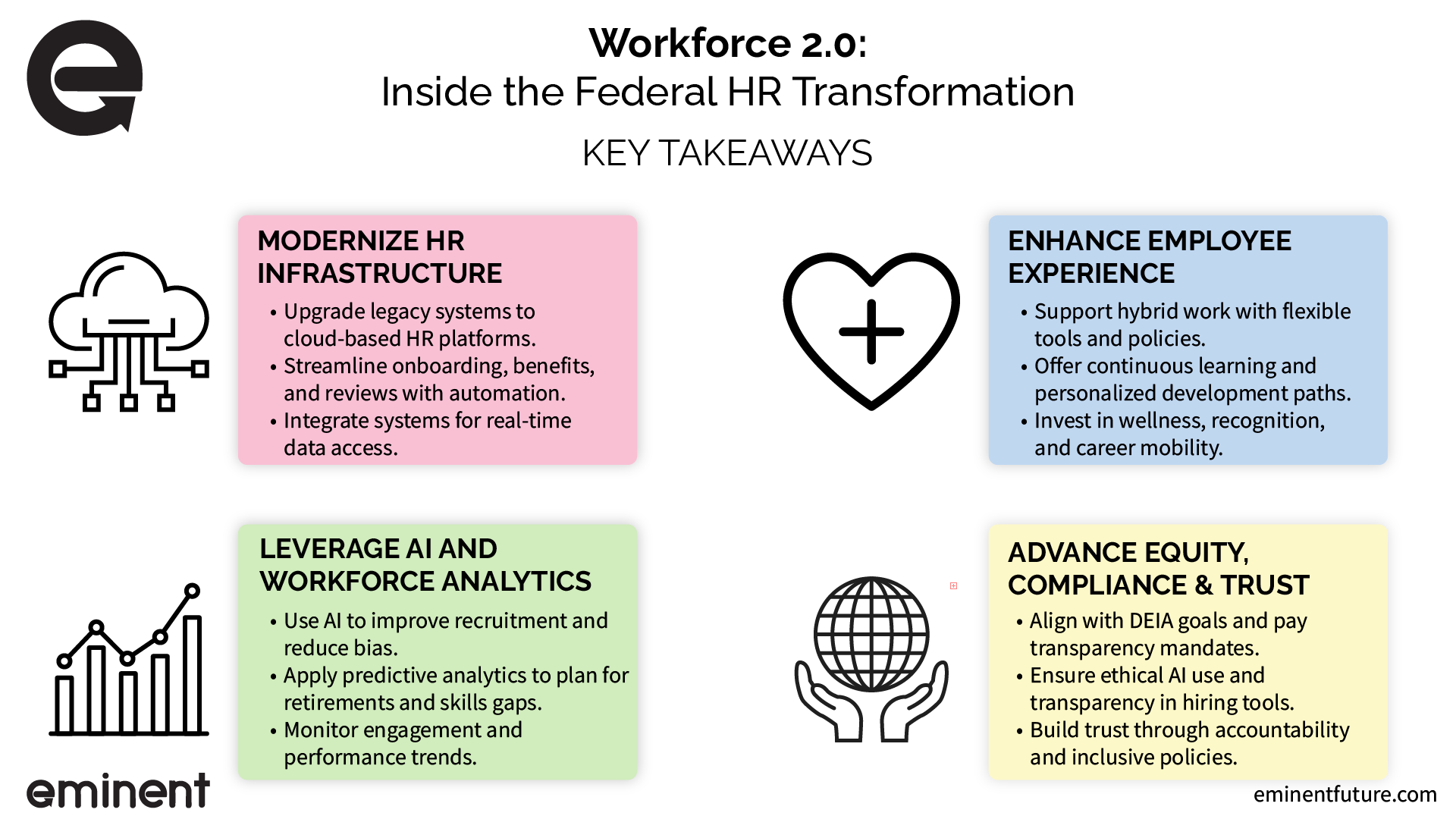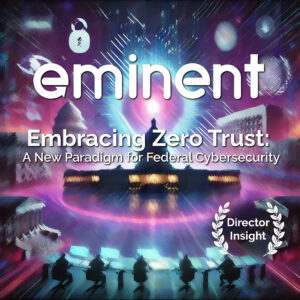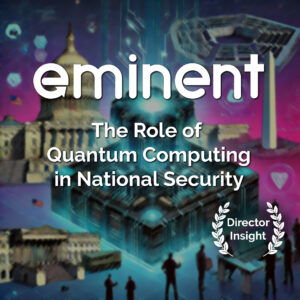Inside the Federal HR Transformation
Federal human resources (HR) is at a pivotal moment. Once centered on compliance, paperwork, and process, HR in the federal space is now being asked to lead transformation. Agencies are grappling with how to modernize operations, attract a new generation of digitally savvy talent, and retain critical institutional knowledge as veteran employees retire in growing numbers.

Workforce shortages, the rise of hybrid and remote work expectations, and aging HR systems compound the challenge. Traditional models no longer meet the expectations of today’s federal workforce—or the pace of mission demands. Federal agencies must rethink how they recruit, engage, and retain talent to remain competitive and responsive.
This blog explores how forward-looking agencies modernize HR using automation, workforce analytics, AI-powered recruiting tools, and employee experience platforms. These strategies are not just about efficiency—they’re essential for building a resilient, mission-ready workforce capable of driving results in a rapidly changing world.
Mission-Critical HR Challenges Facing Federal Agencies

Federal HR teams are under more pressure than ever to modernize—but first, they must overcome some deeply rooted challenges.
1. Talent Gaps and an Aging Workforce
A wave of retirements is already underway, with it goes decades of institutional knowledge. Meanwhile, many agencies struggle to attract younger, tech-savvy professionals who expect flexibility, purpose, and modern tools.
2. Outdated HR Systems
Too many agencies still rely on legacy systems and manual processes. These slow down hiring, make performance tracking difficult and limit the ability to respond quickly to shifting workforce needs.
3. Retention and Engagement Issues
Burnout is rising, especially in hybrid and remote environments. It’s hard to keep top performers motivated and engaged without tools to support connection, feedback, and career growth.
4. Compliance is Getting Complicated
Staying compliant isn’t simple, from DEIA goals to changing labor laws and performance frameworks. Agencies need better data and more agile systems to keep up.
Modernizing HR Through Technology

For decades, federal HR systems have focused more on processes than people. But that’s starting to change. Across agencies, digital transformation is breathing new life into how HR operates—replacing outdated tools with smarter, faster, and more human-centered systems.
Automation That Empowers, Not Replaces
One of the most impactful shifts is the rise of automation and self-service. Instead of paperwork and email chains, employees can now handle tasks like onboarding, benefits elections, and leave requests through intuitive digital portals. This not only saves time but also boosts employee satisfaction by removing unnecessary friction. For HR teams, automation means more time to focus on strategy and support—not data entry.
More innovative Tools for Smarter Decisions
Behind the scenes, artificial intelligence is reshaping recruitment. From scanning resumes to predicting candidate fit, AI tools are helping agencies move beyond traditional hiring models. Rather than waiting weeks to fill a position, HR teams can now surface top candidates in days while reducing unconscious bias in early screening.
Technology isn’t just speeding things up—it’s making HR more strategic. Workforce analytics platforms now provide real-time insights into trends like turnover risk, skills gaps, and engagement levels. With the correct data, HR leaders can shift from reacting to workforce issues to proactively planning for them.
And tying it all together, cloud-based HR systems are helping agencies break free from the limits of legacy infrastructure. These modern platforms support hybrid work, simplify compliance, and improve access for teams across locations. The result? A more connected, agile, and future-ready HR function.
💬 Callout: Experience Drives Retention
According to a 2023 Federal Employee Viewpoint Survey, employees who feel valued and supported are 3x more likely to stay with their agency.
A modern employee experience isn’t a bonus—it’s a retention strategy.
Compliance, Ethics, and Workforce Equity

As federal HR evolves, so do the responsibilities that come with it. Modernizing processes and adopting new technologies isn’t just about efficiency—it’s about doing things correctly. That means ensuring compliance, upholding ethical standards, and advancing equity across the workforce.
Regulations Are Rising—So Are Expectations
Agencies today must navigate a growing landscape of mandates and expectations. From OPM guidelines to pay transparency requirements and DEIA (Diversity, Equity, Inclusion, and Accessibility) directives, staying compliant isn’t a one-time check—it’s a continuous process. With shifting labor laws and increased public scrutiny, HR teams need real-time tools to track, report, and respond.
Building Trust Through Ethical and Inclusive Tech
Technology plays a key role here but must be used responsibly. As AI tools become more common in hiring and workforce analytics, agencies must apply these systems ethically. That means building guardrails to prevent algorithmic bias, maintaining transparency in decision-making, and ensuring human oversight is part of the loop.
More importantly, compliance and equity aren’t just boxes to check—measurable outcomes. Agencies are beginning to adopt data-driven DEIA dashboards that help track progress over time, from hiring demographics to promotion rates, pay equity, and employee sentiment. These insights help leaders make more intelligent, more inclusive decisions and foster trust across the workforce.
The bottom line is that ethics and equity need to evolve alongside technology. When done right, compliance becomes more than a requirement—it becomes a foundation for culture, fairness, and performance.
Overcoming Modernization Barriers

While the case for modernizing federal HR is strong, getting there isn’t always easy. Many agencies face internal and external roadblocks that can slow or stall transformation. The good news is that with the right framing and strategy, these barriers can be overcome.
Budget and Systems: Making the Case for HR Tech
One of the most common hurdles is funding. HR upgrades often compete with other pressing IT or operational needs, and it’s not always clear how to quantify the return on investment. That’s where storytelling and data come together. HR modernization isn’t just about saving time—improving workforce performance, reducing turnover, and increasing mission readiness. Framing it as mission-essential—not just a back-office improvement—can help unlock the funding needed to move forward.
Legacy systems are another major challenge. Many federal HR tools are decades old and not built for integration with modern platforms. A complete rip-and-replace approach can feel overwhelming, but it’s not the only option. Agencies are succeeding with incremental modernization—layering middleware, piloting cloud modules, and gradually replacing outdated components. This step-by-step strategy reduces risk and minimizes disruption.
Change Takes Leadership
Sometimes, the most significant barrier isn’t budget—it’s mindset. Change can feel threatening, especially in organizations where processes have remained the same for years. Resistance from staff or leadership can stall even the most well-funded initiatives.
That’s why change management is critical. From training and internal comms to executive champions who model new tools in action, the human side of transformation matters as much as the technical side. Building buy-in early, setting clear goals, and showing quick wins can help turn skeptics into advocates.
Modernization isn’t just a tech project—it’s a cultural shift. Agencies that approach it holistically are the ones seeing real progress.
The Future of Federal HR Starts Now

Federal HR is no longer just about administration—it’s about shaping the workforce that powers every mission. From attracting the next generation of public servants to retaining institutional knowledge and ensuring equitable, data-driven decision-making, HR is at the heart of federal transformation.
The path forward isn’t without obstacles, but the opportunity is clear. Agencies that embrace automation, AI, and modern employee experience tools are positioning themselves to be more agile, inclusive, and effective.
Modernizing HR isn’t just a tech upgrade—it’s an investment in people. And in the federal space, people are the most important asset.



